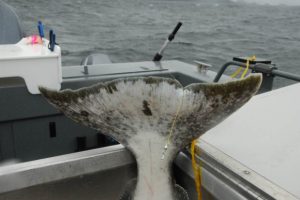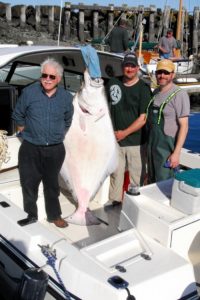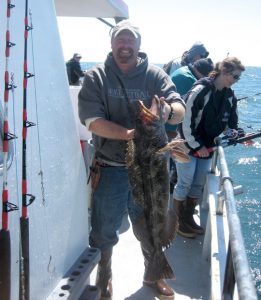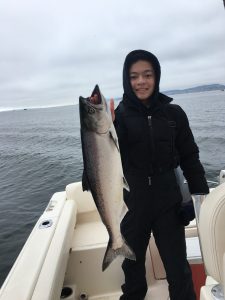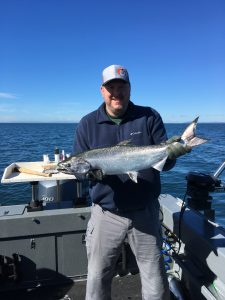Halibut sport quotas set and season starts May 11, and salmon season process meeting is Tuesday Leave a reply
The halibut catch quotas were finalized this past week, and anglers can start making plans to pursue these hard-fighting bottom dwellers when the season gets underway on May 11 off the coast and open areas of Puget Sound.
“The catch quota of 1.19-million pounds (for sport, tribal and non-tribal commercial fisheries) was adopted in Catch Area 2A (Washington, Oregon and California),” said Heather Reed, the state Fish and Wildlife policy coordinator who also mentioned success last year was good in all marine areas open for halibut fishing.
Last year, the catch quota in Area 2A was 1.33-million, and 1.14-million in 2016.
The total Washington sport catch quota this season is 225,366 pounds, down a bit from 237,762 in 2017, and a bump up from 214,110 in 2016, 2015 and 2014.
A breakdown of sport catch quota is 11,182 pounds for the all-depth fishery off Ilwaco (Marine Catch Area 1) with another 500 pounds set aside for a near-shore fishery.
At Westport (Area 2) it is 44,341 pounds for the primary season and 2,000 pounds for a near-shore fishery. At Neah Bay and La Push (Areas 3 and 4) the quota is 111,632 pounds. In Strait of Juan de Fuca/Puget Sound (Areas 5, 6, 7, 8, 9 and 10) the season total is 60,995 pounds.
The halibut fishing dates for Neah Bay, La Push, Westport and Strait of Juan de Fuca/Puget Sound are May 11 and 13, and May 25 and 27. Other potential dates – depending on harvest totals – are June 7, 9, 16, 21, 23, 28 and 30.
The Westport near-shore fishery will open first Saturday after the closure of the primary fishery and be open daily until the quota is projected to be taken.
The opening date at Ilwaco is May 3 for the all-depth fishery. Fishing will be open Thursdays, Fridays and Sundays only, and closes Sept. 30 or until the quota is achieved, whichever comes first. The Ilwaco near-shore season opens May 7, and fishing allowed Mondays through Wednesdays only.
In all areas the daily limit is one halibut with no minimum size limit.
A change in how fishing seasons were structured occurred in 2017 to avoid exceeding catch quotas in Strait of Juan de Fuca/Puget Sound waterways.
Reed says this new guidance and more consistent season has allowed the sport allocation to stay within the guidelines set forth, something that hadn’t been accomplished for several years.
The average size of halibut last year at Neah Bay and La Push was 18 pounds; Ilwaco, 14 pounds; Westport, 16 pounds; and Strait of Juan de Fuca/Puget Sound, 24 pounds.
The most popular fishing area is the northern coast off Neah Bay and La Push at Swiftsure Bank located 10 to 14 miles west of Cape Flattery; Blue Dot; 72 Square; Table Top; the Prairie; Umatilla Reef; Garbage Dump; Waadah Island; and Duncan Rock.
In the Strait of Juan de Fuca try off the mouth of the Sekiu River and Hoko River; Eagle Bay; Clallam Bay; Slip Point; Whiskey Creek; Freshwater Bay; Green Point east of Port Angeles; and Rock Pile north of Ediz Hook.
Good underwater shelfs where halibut tend to hug the bottoms are Coyote, Hein, Middle, Eastern and Partridge banks as well as inner-waterways like Mutiny Bank, Bombing Range, Midchannel Bank off Port Townsend, Admiralty Bay on west side of Whidbey Island; and Useless Bay.
Once you get your fill of halibut, be sure to get your fill of black rockfish and lingcod, which opened on March 10 at Ilwaco, Westport and La Push. Neah Bay is also open for bottomfish fishing except the lingcod fishery opens April 16.
The black rockfish population remains strong off the coast. A spike in the canary rockfish population will also allow sport anglers to keep one daily off Ilwaco and Westport only as part of an anglers seven rockfish daily limit. Fishing for canary rockfish is still off limits at La Push and Neah Bay.
Sport anglers may keep all lingcod regardless of their size. Anglers should also be aware of certain depth restrictions in coastal deep-water lingcod fisheries.
Sport anglers who pursue halibut and bottomfish are now required to carry a descending device onboard their boat in all marine areas, including the coast.
Descending devices are used to release rockfish back to the depth and improve their survival when released. For details, go to http://wdfw.wa.gov/fishing/bottomfish/rockfish/mortality.html.
North of Falcon salmon meeting is Tuesday
A little more than a week remains before state fisheries and Pacific Fishery Management Council develop final salmon fishing seasons for Puget Sound, Strait of Juan de Fuca and coast.
In a move to create more transparency in the process the state and tribal co-managers on Tuesday’s North of Falcon meeting will offer an open joint session where the public can take part at 1 p.m. at the Lynnwood Embassy Suites, 20610 44th Ave. West.
The discussion will cover a variety of topics on salmon-related issues including conservation objectives for Puget Sound chinook salmon, habitat restoration efforts and salmon fisheries. The public will be invited to ask questions after brief opening remarks by the state and tribal co-managers.
”We are working very hard on the (NOF) process and have the commitment from our co-managers to have a better understanding of salmon issues and to work together on getting to an agreement even though we have our own differences,” said Ron Warren, the WDFW assistant director.
In the first North of Falcon meeting on March 20, an early “wish list” of fisheries were created with the emphasis put on being cautious on some wild salmon returns that have fallen into the poor status category.
One highlight is hopefully getting a Puget Sound coho fishing in late-summer and early-fall, which has faced some tough times in recent years due to very poor returns. In the Strait of Juan de Fuca, Sekiu and Port Angeles could also see a hatchery coho season from July through mid-September.
For hatchery-marked chinook, a proposed fishery Sekiu and Port Angeles would see it open from July through mid-August. Then reopen at Sekiu mid-March 2019 through April and at Port Angeles from March 2019 through April 2019.
Northern Puget Sound is earmarked for the normal mid-July through mid-August hatchery-marked chinook fishery as well as from December through April 2019.
A central Puget Sound hatchery-marked chinook fishery could happen from mid-July through August and November through April 2019. There also might be more time on the water in inner-Elliott Bay, a popular summer fishery right in front of the Emerald City skyline.
The south-central Puget Sound proposed hatchery-marked chinook season would go from June through April 2019.
The three sport ocean salmon fishing options show summer seasons will likely be somewhat slimmer than last year in the overall catch quotas as some salmon returns to the Columbia River are going to be down.
The final seasons will be adopted at the Pacific Fishery Management Council meetings on April 6-11 at Sheraton Portland Airport Hotel, 8235 N.E. Airport Way in Portland, Oregon.
In meantime public comment is being accepted on the WDFW website at https://wdfw.wa.gov/fishing/northfalcon/. You can also view a list of other public meetings as well as salmon run-size forecasts.


